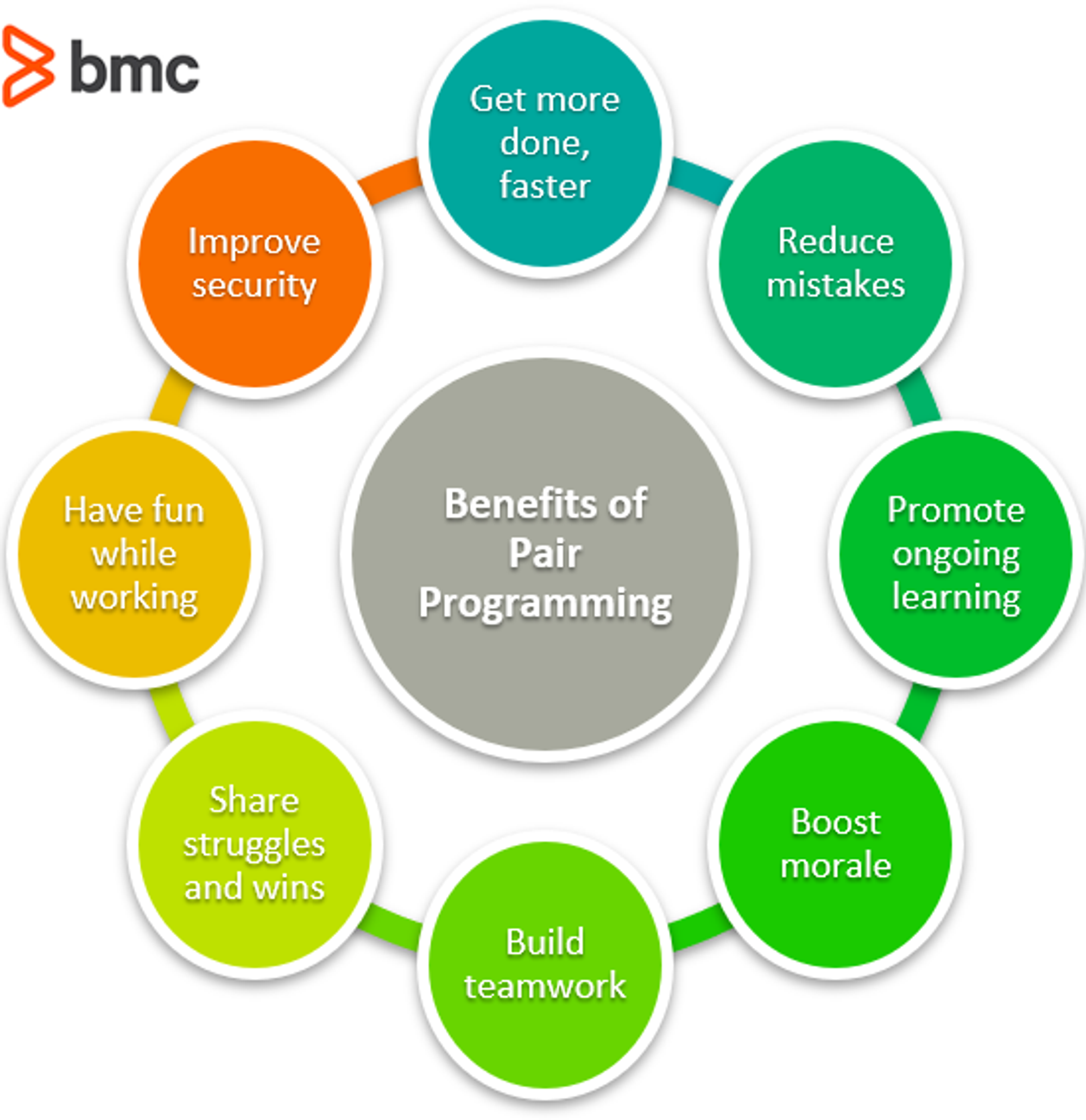The Benefits of Pair Programming
Pair programming is a collaborative programming technique that involves two programmers working together on a single workstation [2]. While this approach may seem counterintuitive at first, it has been shown to provide numerous benefits for both programmers and companies alike.
All the thoughts presented here are based on my experience and feelings throughout my development career. I do not have any empirical evidence to justify my points. However, I do believe most of you would see my points. I am not affiliated to any software or books presented on this blog. I am citing or referencing them because I am familiar with those and believe provides more detail evidence of arguments I am making here.
Encouraging Team Cohesion through Pair Programming
Pair programming has numerous benefits, including its ability to build team cohesion. Like any other development team, competition among members can sometimes arise, which can be beneficial in setting personal objectives and excelling in work. However, a balance must be struck between teamwork and competition to ensure team cohesion and prevent demotivation or even turnover.
When developers work individually on the same code base, they may develop toxic behaviour when they encounter a solution that diverges from what the development team would have done, believing they know better. Some even aspire to be the go-to person a team can't function without. When done extensively and with frequent rotations within a group, Pair programming facilitates putting all developers on the same page. By actively discussing and challenging solutions to problems with their team, developers become accountable for the entire code base.
Moreover, pair programming requires you to be your authentic self, not the person you aspire to be. You have to remove your shield and expose your vulnerability to get the most out of any pair programming sessions. But this is okay, as it promises a healthier environment with empathetic colleagues who care about the team and share the same goal of succeeding together.
Pair programming can transform how developer teams communicate and share knowledge internally. As curious live beings by nature, developers should schedule some time with another developer in their group to tackle a complex problem they have been struggling with for a long time. They can sit next to each other or pair remotely using systems like Drovio.
Remember, pairing is sharing, and pairing is caring. Pair widely to promote team cohesion and achieve success together.Increased Productivity
One of the primary benefits of pair programming is that it can lead to increased productivity. By working together, programmers can bounce ideas off of one another, catch errors more quickly, and spot potential problems before they become major issues. Additionally, pair programming can help reduce the amount of time spent debugging code, as two sets of eyes are better than one.
Reduced Bus Factor
Another benefit of pair programming is that it can help reduce the
"bus factor" of a project. The bus factor refers to the number of people on a team who would need to be hit by a bus (i.e., leave the project unexpectedly) before the project is in serious trouble. By having two people working on a particular piece of code, the bus factor is automatically reduced.Removal of Technical Debt
Pair programming can also help remove technical debt from a project. Technical debt refers to the idea that, over time, code can become outdated or inefficient, which can lead to a variety of problems down the line. By working together, programmers can identify areas of code that may need to be refactored or optimized, helping to ensure that the overall quality of the codebase remains high.
Common Understanding of the Product
Finally, pair programming can help ensure that all members of a team have a common understanding of the product. By working together, programmers can share knowledge and experience, which can help ensure that everyone is on the same page when it comes to the goals and objectives of the project.
Share best practices
One of the benefits of pair programming is the ability to share best practices with your team. Coding is not a one-size-fits-all task, as our brains approach problems differently, and we all use strategies that have previously yielded results. After years of coding, we develop automatic habits, and the best thing we can do for our team is to share these habits openly. By doing so, younger developers can ramp up quickly, build their practices in the long run, and ensure everyone is on the same page.
Pair programming is an effective way to share best practices, as it allows you to demonstrate the value of these habits in real and concrete situations. There may need to be more than just sharing your best coding practices playbook for juniors to fully ramp up, and telling seniors to write good tickets, elaborate on issues, or test their code effectively may not be effective either. Active communication and leading by example are crucial, and pair programming provides a valuable tool for achieving this goal.
Eliminate distractions
Staying focused while coding solo can be challenging, especially when tackling complex problems. As naturally curious individuals, we explore various solutions to satisfy our inquisitive minds. However, this often results in erasing hours of effort and reverting to a more straightforward solution. Pair programming comes in handy in situations like these, keeping us motivated and accountable to one another while minimizing distractions such as email notifications and phone calls. Although it may lead to fatigue, regular breaks can help combat this. Additionally, student and professional programmers consistently find pair programming more enjoyable than working alone [1].
Use Cases
Pair programming has been proven to work in a variety of settings. For example, a study conducted by the University of Utah found that pair programming improved code quality by 15 percent on average, while also reducing the amount of time spent on debugging by 35 percent. Additionally, the book "Extreme Programming Explained" by Kent Beck and Cynthia Andres provides numerous case studies of successful pair programming implementations.
In conclusion, pair programming can provide numerous benefits for both programmers and companies alike. By increasing productivity, reducing the bus factor, removing technical debt, and promoting a common understanding of the product, pair programming can help companies save time and money while also improving the quality of their codebase.
Additional Benefits of Pair Programming
In addition to the benefits mentioned earlier, pair programming can also lead to better communication and collaboration among team members. By working together, programmers can develop a shared language and coding style, which can help reduce misunderstandings and conflicts down the line. Additionally, pair programming can foster a sense of teamwork and camaraderie, which can help improve morale and job satisfaction.
Another benefit of pair programming is that it can help improve the skills of less experienced programmers. By working with a more experienced partner, less experienced programmers can learn new techniques and best practices, which can help them improve their skills and become more effective programmers over time.
Conclusion
Overall, pair programming is a highly effective technique for improving the productivity, quality, and teamwork of development teams. By working together, programmers can catch errors more quickly, improve code quality, and develop a shared understanding of the project goals and objectives. Whether you are a software development team or an aerospace engineering team, pair programming is a technique that is well worth considering.
One of the benefits of pair programming is the ability to share best practices with your team. Coding is not a one-size-fits-all task, as our brains approach problems differently, and we all use strategies that have previously yielded results. After years of coding, we develop automatic habits, and the best thing we can do for our team is to share these habits openly. By doing so, younger developers can ramp up quickly, build their practices in the long run, and ensure everyone is on the same page.
Pair programming is an effective way to share best practices, as it allows you to demonstrate the value of these habits in real and concrete situations. There may need to be more than just sharing your best coding practices playbook for juniors to fully ramp up, and telling seniors to write good tickets, elaborate on issues, or test their code effectively may not be effective either. Active communication and leading by example are crucial, and pair programming provides a valuable tool for achieving this goal.
- Strengthening the Case for Pair Programming, Laurie Williams, North Carolina State University Robert R. Kessler, University of Utah Ward Cunningham, Cunningham & Cunningham Ron Jeffries, July/August 2000 IEEE SOFTWARE
- Pair Programming, https://wiki.c2.com/?PairProgramming


